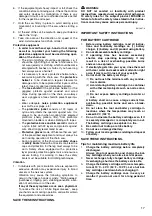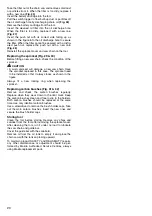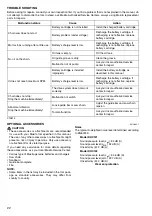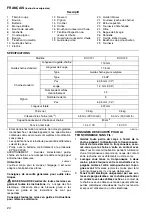
16
5.
Always keep proper footing.
Slippery or unstable
surfaces may cause a loss of balance or control of
the chain saw.
6.
When cutting a limb that is under tension be
alert for spring back.
When the tension in the wood
fibers is released the spring loaded limb may strike
the operator and/or throw the chain saw out of con-
trol.
7.
Use extreme caution when cutting brush and
saplings.
The slender material may catch the saw
chain and be whipped toward you or pull you off bal-
ance.
8.
Carry the chain saw by the front handle with the
chain saw switched off and away from your body.
When transporting or storing the chain saw
always fit the guide bar cover.
Proper handling of
the chain saw will reduce the likelihood of accidental
contact with the moving saw chain.
9.
Follow instructions for lubricating, chain ten-
sioning and changing accessories.
Improperly
tensioned or lubricated chain may either break or
increase the chance for kickback.
10.
Keep handles dry, clean, and free from oil and
grease.
Greasy, oily handles are slippery causing
loss of control.
11.
Cut wood only. Do not use chain saw for pur-
poses not intended. For example: do not use
chain saw for cutting plastic, masonry or non-
wood building materials.
Use of the chain saw for
operations different than intended could result in a
hazardous situation.
12.
Causes and operator prevention of kickback:
Kickback may occur when the nose or tip of the
guide bar touches an object, or when the wood
closes in and pinches the saw chain in the cut.
Tip contact in some cases may cause a sudden
reverse reaction, kicking the guide bar up and back
towards the operator.
Pinching the saw chain along the top of the guide
bar may push the guide bar rapidly back towards the
operator.
Either of these reactions may cause you to lose con-
trol of the saw which could result in serious personal
injury. Do not rely exclusively upon the safety
devices built into your saw. As a chain saw user, you
should take several steps to keep your cutting jobs
free from accident or injury.
Kickback is the result of tool misuse and/or incorrect
operating procedures or conditions and can be
avoided by taking proper precautions as given
below:
–
Maintain a firm grip, with thumbs and fingers
encircling the chain saw handles, with both
hands on the saw and position your body and
arm to allow you to resist kickback forces.
Kickback forces can be controlled by the operator,
if proper precautions are taken. Do not let go of
the chain saw.
–
Do not overreach and do not cut above shoul-
der height.
This helps prevent unintended tip
contact and enables better control of the chain
saw in unexpected situations.
–
Only use replacement bars and chains speci-
fied by the manufacturer.
Incorrect replacement
bars and chains may cause chain breakage and/
or kickback.
–
Follow the manufacturer’s sharpening and
maintenance instructions for the saw chain.
Decreasing the depth gauge height can lead to
increased kickback.
13. Before starting work, check that the chain saw is in
proper working order and that its condition complies
with the safety regulations. Check in particular that:
•
The run-down brake is working properly;
•
The bar and the sprocket cover are fitted cor-
rectly;
•
The chain has been sharpened and tensioned in
accordance with the regulations;
14.
Do not start the chain saw with the chain cover
being installed on it.
Starting the chain saw with
the chain cover being installed on it may cause the
chain cover to thrown out forward resulting in per-
sonal injury and damage to objects around the oper-
ator.
Top handle chainsaw specific safety warnings
1.
This chain saw is designed especially for tree care
and surgery. The chain saw is intended to be used
by properly trained persons only. Observe all instruc-
tions, procedures and recommendations from the
relevant professional organization. Otherwise fatal
accidents may occur. It is recommend that always
using a rising platform (cherry picker, lift) for sawing
in trees. Rappelling techniques are extremely dan-
gerous and require special training. The operators
must be trained to become familiar with safety equip-
ment usage and climbing techniques. Always use
the appropriate belts, ropes and carabiners when
working in trees. Always use restraining equipment
for both the operator and the saw.
2.
Perform cleaning and maintenance before storage in
accordance with the instruction manual.
3.
Ensure safe positioning of the chain saw during car
transportation to avoid fuel or chain oil leakage,
damage to the tool and personal injury.
4.
Do not fill the chain oil near fire. Never smoke when
you fill the chain oil.
5.
National regulation may restrict the use of the chain
saw.
014673
Summary of Contents for DUC122ZK
Page 5: ...5 4 1 2 3 4 5 9 10 11 7 8 5 6 1 2 3 012143 012128 008572 008566 008568 ...
Page 6: ...6 6 7 8 9 10 11 1 2 14 15 7 12 10 13 12 013715 013716 008569 008570 008587 008570 ...
Page 8: ...8 20 21 22 23 24 25 26 27 24 24 22 23 008633 006927 006929 008578 008579 008580 008581 008582 ...
Page 9: ...9 28 29 30 31 32 28 29 27 25 13 26 13 25 008635 008584 008586 008585 001145 22 ...
Page 102: ...102 ...
Page 103: ...103 ...
Page 104: ...Makita Corporation Anjo Aichi Japan www makita com 885298 995 IDE ...
















































